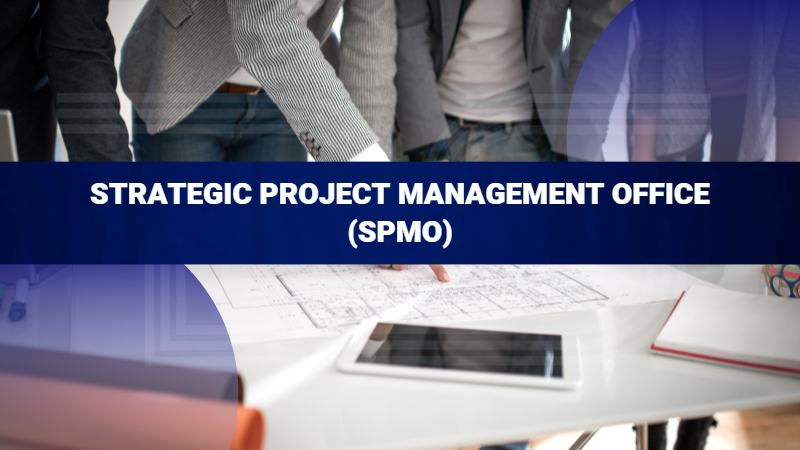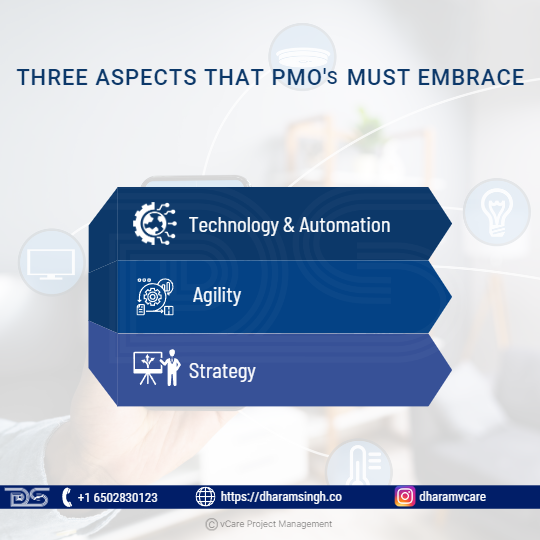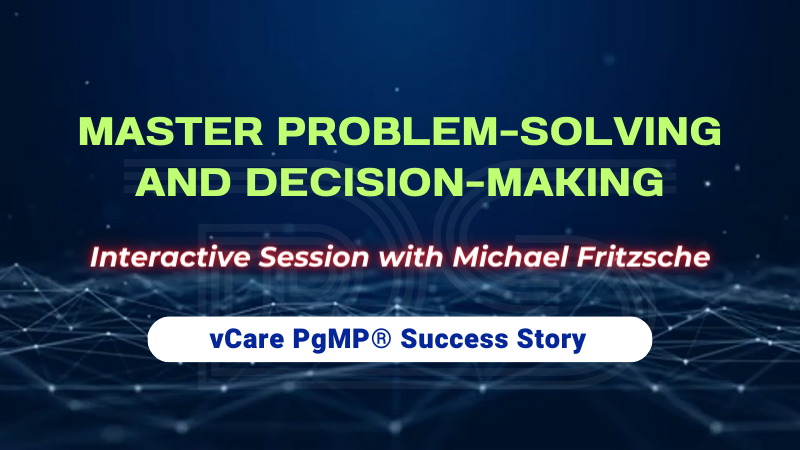
by DharamCW | May 7, 2023 | General
The project management office (PMO) is increasingly evolving from an administrative role to one that is strategic and more closely connected with business drivers. As a result, the PMO plays an important role in generating corporate value as the pace of business rises along with the expectation of faster returns on investment.
Traditional administrative PMOs fall short of meeting this need. Therefore, a mindset change and a reinvented project delivery capability that is both commercially astute and agile are required. Furthermore, such a PMO must comprehend and implement the plan.
In this article, we’ll look at the factors driving the shift to strategic project management offices (SPMO), also known as Enterprise PMO or EPMO, the essential features of a value-adding PMO, and game changer ideas to help you alter your PMO and improve its profile in your business.

What is Strategic PMO (SPMO)?
Strategic PMO (SPMO)
A Strategic PMO is a project-centric business department that should be structured and managed like other business departments – with enterprise leadership setting goals and objectives that assist the organization in thriving. The demands of individual organizations will lead to variations in what it means in specific terms. Still, we can expect a focus on the following areas:
- Portfolio management – Generation of ideas, selection, execution, and realization of benefits. Portfolio Management is a huge area, and organizations will adapt to it as it becomes increasingly crucial.
- Financial management – The PMO, closely linked to portfolio management, must be accountable for ensuring that project investments are acceptable and fit with business goals. The PMO must also guarantee competent budget management during project execution. Furthermore, the PMO should be held accountable for monitoring and tracking the benefit realization tasks of the business units.
- Enterprise-wide project-related processes and approaches Strategic risk management (i.e., managing the portfolio’s organizational risk exposure, proactive risk selection to match organizational tolerance, and so on), integration of finance and benefits, consistent quality standards, and so on.

Focus areas of Strategic PMO
- Proactive resource management – Capacity and capability planning, skills inventory management, and so on – ensuring that the project execution functions have the appropriate people with the right skills at the right time.
- Strategic partner – This borders on cultural change, creating the PMO as an independent and impartial consultant to the organization on project execution. PMOs, like IT, must demonstrate that they are business leaders supporting the organization’s work rather than a tactical execution-only function.
Different levels of PMO strategic alignment
Within an organization, a PMO can function at three stages of ‘Strategic’ maturity:

Different levels of PMO strategic alignment
- Strategy Creation – Strategy Creation entails assisting organizations in determining which strategic options to pursue (and then translating them into projects – Strategy Delivery – and managing their success – Strategy Management). It is unusual for a PMO to achieve this level of trust and influence inside an organization. Still, it is the (possible) future for the enterprise PMO that is effectively embedded within an organization and fortunate with the right sponsorship.
- Strategy Delivery – Strategy Delivery is the process through which the PMO turns important strategy objectives into new projects to be added to the portfolio (and perhaps to remove some from the portfolio if such objectives have changed). The ‘Strategy Supervision’ capability backs up this ‘Strategy Delivery’ capability. The PMO may also take direct responsibility for the execution of large and complex programs (or projects) that are specifically critical to a key strategic effort, such as relocation activities.
- Strategy Supervision – Strategy Supervision of strategic intents through project ownership, each of which should directly or indirectly link to a strategic intention of the overall organization. ‘Strategy Supervision’ is where the PMO acts as the Executive’s governing and advisory body by:
- Validating that all projects undertaken correspond to one or more strategic initiatives.
- Monitoring the current and right alignment of projects and strategy.
- Making stall-and-kill recommendations for initiatives no longer correspond with current corporate strategic thinking.
Five Steps to Creating the Strategic Enterprise Project Management Office (SPMO)
Today’s organizations recognize that fewer and fewer initiatives are self-contained inside individual departments and increasingly straddle multiple business functions. Project management offices (PMOs) have traditionally been connected with IT, partly due to technology’s role in all projects. However, with technology increasingly transitioning to contribute to those business transformation initiatives, keeping the PMO as an IT role is ineffective.
The appropriate response to this trend is a single, enterprise-wide EPMO. Many firms using EPMOs, however, fail to perceive an increase in project execution speed. In addition, here are the five key steps to achieving long-term EPMO success:

Five Steps to Creating SPMO
- Define the company’s goal.
- Create appropriate leadership and accountability structures.
- Communicate the purpose, responsibilities, and alignment.
- Respond to measurements and outcomes.
- Create a road map for actual evolution into a business function.
The Rise of the Strategic PMO
The strategic PMO may play a crucial role as a custodian and evangelist for business benefits realization, giving important information to the Executive on which projects deliver value across the organization. In addition, the insights provided by the SPMO may help with crucial decisions like which initiatives to fund, which projects to kill, or re-prioritizing or re-balancing work portfolios to reflect changing business or market conditions.
Not all PMOs must be strategic in character. For example, a PMO embedded within a project or program might focus on the project’s day-to-day resource management and administrative needs. However, the decision to start the project should have been taken at a strategic level. From the start, the project-level PMO should have been aligned with the Strategic PMO’s reporting and governance structure. The SPMO should be able to make micro and macro business choices based on accurate and timely project data flow up into the program and, eventually, portfolio level.
The Strategic PMO plays a key role in championing and driving business value for the organization and being an effective change enabler. Here are the five major game changers that will propel the PMO and project organization to the next level.

5 Major game changers that will propel the PMO and project organization to the next level
- Demonstrating Project Leadership and Vision
- The Importance of Realistic Planning
- A Culture of Disciplined Execution
- Effective Stakeholder and Change Management
- Creating a “Value Lens” for Managing Enterprise Investment
The strategic project management office is critical to increasing project maturity and optimizing the organization’s business return on project investment. People, processes, data, and technologies must all be prioritized to achieve this objective. Project management is a multifaceted endeavor that is both an art and a science.
Leveraging the future of PMO to drive new strategic opportunities
In recent years, businesses have been subjected to a slew of external forces, the most significant of which has been Covid-19. These disruptors have caused firms to adapt, whether to work around obstacles, shift to new working methods, or adapt to Industry 4.0. All of these variables influence organizational complexity, both strategically and operationally. Businesses must not only respond proactively to all of this complexity; they must also prosper while operating in a resource-constrained environment. As a result, today, more than ever, the PMO’s ability to efficiently deliver projects and transform organizations of all kinds and across many locations is critical to achieving their goals.
Projects must be completed at scale to create transformation for a company effectively. A McKinsey & Company study of over 5000 large-scale projects discovered that 56% generated less value than planned, 45% went over budget, and 17% were so disastrous that the organization’s survival was threatened. This study highlights the need to make adequate efforts to select PMOs who can adapt to the future of work.
Historically, PMOs have been viewed as lacking a clear identity or purpose within an organization; however, the future-state PMO is an enabler of business value creation, collaborating with business leaders to provide a clear and achievable roadmap while making the best use of the organization’s limited resources.

3 Aspects that PMOs must embrace
PMOs must also adjust to the new normal and growing business demands. The three areas described below represent the fundamental features that PMOs of the present and future must embrace to manage change effectively.
- Technology & Automation
Because Covid-19 has accelerated the way we utilize technology in our daily work, technology is expected to be front and center, enabling PMOs to deliver more successfully. To effectively adapt to new methods of working and build a “single source of truth,” advanced technologies and cloud-based solutions will be required. This technology jump is critical for borderless operations in which progress and transparent communication must be readily available and updated in real-time to allow for swift decision-making.
In the future world, both artificial intelligence and machine learning will be important facilitators of automating PMO procedures, delivering superior insights, and allowing teams to spend less time on manual transactional processing and more time generating value for projects. For example, project planning is often based on data collection, industry benchmarking, and using the experience of project managers. However, according to PMI – AI Innovators, there is still a significant inefficiency in project management, with around 1/3 of traditional project management activities requiring one or more days of manually collating reports. Using IoT and big data to automate various tedious processes allows the PMO to create more realistic and effective timetables and spot potential disruptors.
However, it is unlikely that technology will completely replace project managers, with the PMI forecasting that businesses will require over 88 million project managers by 2027. As a result, PMs will be expected to improve their competencies and fully utilize the available technologies.
PMOs will be required to lead by example in their automation projects, advocating new methods of working with their collaborative organization in the future. As a result, the paradigm of efficiently providing workstreams may evolve, driving firms to become more digital.
- Agility
With an increased level of complexity for transformation and multiple stakeholders to handle, projects may need to adapt and pivot in other ways than originally planned. Changes in priorities (39%) and objectives (37%) and the inability to adapt are the two leading reasons for project failure, according to PMI.
As a result, PMOs that can be responsive to change needs continually are critical to fulfilling project milestones, which might mean the difference between being an industry leader or a laggard. An agile PMO’s guiding principles are as follows:
- Decentralization of planning and decision-making
- Agile resource allocation and reallocation
- Workflows that are effective for continuous project advancement
An agile PMO may demonstrate agility by altering priorities and reallocating resources to achieve new objectives while transitioning seamlessly from reorganization to continuous delivery. Furthermore, decisions are decentralized, allowing faster response rates for recognizing and reducing hazards. Finally, communication is critical, with fewer layers of approval, and output is assessed by how much work can be done in a particular sprint.
However, merely establishing an agile PMO will only solve some difficulties; 47% of agile projects are late, have budget overruns, or result in dissatisfied consumers. A cultural revolution is required to fully realize agile’s potential, beginning with the leadership team and spreading across the firm.
As a result, the PMO cannot only act as an intermediary but also as a business partner, working alongside the leadership team and the rest of the organization. Team members must be self-sufficient, accountable, and have complete insight into project progress and data.
- Strategy
The PMO’s role must evolve from a team offering mere assurance to becoming a strategic partner with a vested interest in aligning with the organization’s ability to carry out its plan. As a result, the team is expected to have stronger strategic oversight of all work streams to deliver value throughout the project.
PMOs will be required to go beyond task completion and monitoring to include:
- Portfolio planning entails generating ideas for the activities required to capitalize on the opportunity.
- Project prioritizing entails determining the most effective timeframe and budgeting by the company’s demands.
- Capacity planning entails assigning the appropriate skills and resources to each work team.
- Resilience planning entails anticipating future obstacles and reducing interruptions.
- The strategic partnership is a cultural transformation in management and the PMO. The PMO is viewed as a business leader and adviser with a stake in the organization’s goals.
The key to success is consistent stakeholder engagement, with the PMO and business leaders holding frequent strategic discussions to monitor and coordinate company strategy and broad strategic objectives. This consistency will build a collaborative strategic management process and a fluid communication channel to adjust quickly and efficiently.
The future PMO will be more strategic and intricate in character than conventional models, emphasizing driving decision-making, execution, and outcomes while becoming more decentralized to interact with each workstream to achieve one common goal efficiently. Finally, PMOs will be more crucial than ever in addressing the complexities that organizations are now confronting. An effective transformation will need PMOs to serve as the organization’s voice and face.

Strategic project management office’s role in strategy execution
Strategic project management office’s role in strategy execution
Identifying, implementing, and managing strategic initiatives is critical to strategy execution. The strategies are implemented by creating strategic initiatives to support strategic objectives and fill gaps in strategic measures, and the value gap is bridged. Only projects that are connected with the strategic goal should be accepted.
When defining strategic initiatives/projects, the sequence of initiative execution is crucial since all related strategic initiatives must finish and provide value. The strategic initiatives cover almost all departments and corporate shared services. As governance becomes more important in project management, portfolios and programs are defined.
- Strategic initiatives are linked to similar programs and project execution.
- The projects will be managed by program managers, project managers, and another project team.
- Connecting programs and projects creates portfolios for portfolio managers and other project governance teams.
- Project, program, and portfolio definition is an iterative process reviewed multiple times to ensure interconnectivity and value generation.
Portfolio, program, and project management are critical components of strategy execution. Hence, everything is referred to as a Strategic Project Management Office (SPMO) or Enterprise Project Management Office (EPMO).
Final Thoughts
Organizations can only thrive in a highly competitive world if they innovate. Such innovation must occur at all levels of the organization, including goods, services, business processes, and business models.
The PMO has the authority to execute the innovation at all levels. Good project management regulates and fosters innovation through projects—customer satisfaction and profit growth when consistent outcomes are predictable. Project and program management practices establish the foundation for dependable plan execution. The efficacy of the organization’s initiatives and programs will influence corporate success when such practices are implemented throughout the organization.
The project management office (PMO) is a key change management component, working with other organizational structures, such as functional units, to improve project management competencies. However, in today’s competitive environment, businesses must rely on more than just solid strategies to secure success.
To succeed, managers must build organizations capable of attaining their strategic objectives faster than their competitors. This initiative involves the creation of organizations capable of performing today’s tasks more effectively while anticipating future disruptions. Successful execution of creative and strategic concepts leads to innovation. Competitive advantage is as much about execution as it is about strategy.
Feel free to check out my discussion on this topic with Justin Buckwalter in YouTube
For any questions related to your Project Management career, training, and certifications, you can book an obligation free 15 minutes session with me by visiting http://talktodharam.com/
You can subscribe to the vCare Project Management YouTube Channel to catch future videos of our Q&A series and certification success stories: https://bit.ly/2YF0wJl
You can subscribe to and follow my podcasts and interviews with Project Management Experts on YouTube at https://bit.ly/2NDY8wd












Recent Comments